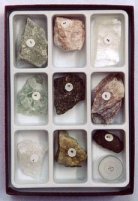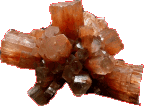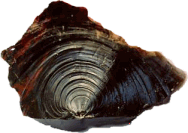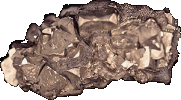| Mohs Scale | ||
| Mineral ________ | Hardness ________ | |
| Talc | 1 | 
|
| Gypsum | 2 | |
| Calcite | 3 | |
| Fluorite | 4 | |
| Apatite | 5 | |
| Orthoclase | 6 | |
| Quartz | 7 | |
| Topaz | 8 | |
| Corundum | 9 | |
| Diamond | 10 | Hardness Set |

Hardness is the resistance of minerals to scratching or abrasion. It is one of the easiest properties to study and it is a very useful diagnostic tool for the classification of unknown minerals. In 1812 a German mineralogist, Frederich Mohs, devised a hardness scale of rocks by selecting ten common minerals. This scale, commonly known as the Mohs scale, is now regarded as standard for the classification of rock hardness. The table below lists the set of minerals selected by Mohs and their hardness. It is important to note that this is not a linear scale, so for example, Corundum with a designated hardness number of 8 is twice as hard as Topaz (hardness 7), but four times as soft as Diamond. There are easily obtainable hardness sets to measure the hardness of unknown specimens. The picture next to the Mohs scale shows one of them. If you have a reasonable number of rocks you can probably assemble the scale from your own collection. More advanced sets are now also on the market based on pens containing tips of different hardness(see picture on the top left) but these are more expensive. If you do not want to buy anything commercially, you can still get a long way in finding out the hardness of your specimen if you know that:
| Mohs Scale | ||
| Mineral ________ | Hardness ________ | |
| Talc | 1 | 
|
| Gypsum | 2 | |
| Calcite | 3 | |
| Fluorite | 4 | |
| Apatite | 5 | |
| Orthoclase | 6 | |
| Quartz | 7 | |
| Topaz | 8 | |
| Corundum | 9 | |
| Diamond | 10 | Hardness Set |
Density is defined as the average mass per unit volume and is another fundamental property of rocks and minerals. Density is usually expressed as grams per cubic centimeter. Density depends on several factors including the kind of atoms in the structure and how closely they pack together - the heavier the atoms or the more closely packed they are, the greater the density. Obtaining rock density is simple and can be done in three steps:
However, if you do not have a balance from which you can suspend a rock on a string and immerse it in water; there is another method:
Cleavage or fracture describes the way the mineral breaks.
It is called:
Cleavage - if the mineral breaks along a plane surface, parallel to the crystal face. Cleavage occurs because of the differences in the strength of the bonds between different atoms or planes of atoms. A good example of a mineral which cleaves is mica. Mica splits easily into thin sheets. Galena is another example of mineral which cleaves. Galena breaks into cubes called “cubic cleavage". Aragonite is distinguished by a perfect rhombohedral cleavage.

| 
|
| cleavage into sheets | rhombohedral cleavage |

| 
|
| conchoidal fracture | hackly fracture |
| _______________________________ | ||||
| Home | | | Shopping | | | Database |
© Biscuit Software 2004-2015
All rights reserved